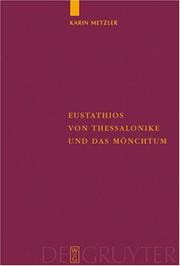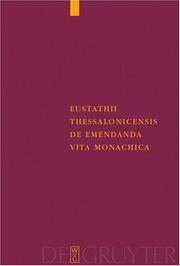| Listing 1 - 5 of 5 |
Sort by
|
Book
ISBN: 9783700181040 3700181043 Year: 2018 Volume: 4 42 504 Publisher: Wien: Verlag der Österreichischen Akademie der Wissenschaften,
Abstract | Keywords | Export | Availability | Bookmark
 Loading...
Loading...Choose an application
- Reference Manager
- EndNote
- RefWorks (Direct export to RefWorks)
Byzantium plays a vital role for the transmission of ancient, late antique and Medieval Greek texts. Thousands of manuscripts preserved in libraries and collections are full of texts of ancient tragedians, late antique church fathers and particularly of Biblical texts, which represent the lion’s share of transmitted manuscripts. A considerable number of manuscripts, depending on the setting in which they were copied, are equipped with illuminations or various kinds of ornamentation which increase their value. These often very elaborately and colorfully designed depictions are usually accompanied by texts, which, due to not belonging to the main text of the manuscript, are called paratexts. A considerable number of these paratexts are in verse form. Such texts, called book epigrams, fulfill various functions: they explain the depicted scenes, highlight the relationship between the manuscript’s main text and the illumination, or act themselves as images, as for example when the text of the epigram is written in the shape of a cross or inscribed into an ornamental frame. Many of these texts, considered purely on visual grounds, already resemble inscriptions which are preserved on other kinds of surfaces and objects. The current volume is structured like the preceding three volumes of the series Byzantine epigrams on objects, which have so far presented inscriptional verses on frescoes and mosaics; icons and portable objects; and on stones. The publication’s focus is on critical editions of the texts, (German) translations of the Greek texts, and commentaries. Besides general chapters on the cultural-historical phenomenon of quasi-inscriptional verses in manuscripts, paleography, language etc., almost all the epigrams treated are also depicted in the volume’s collection of plates in order to facilitate study of the original context of the verses.
Book
ISBN: 9783777425313 3777425311 Year: 2010 Publisher: München: Hirmer,
Abstract | Keywords | Export | Availability | Bookmark
 Loading...
Loading...Choose an application
- Reference Manager
- EndNote
- RefWorks (Direct export to RefWorks)
Art, Byzantine --- Art byzantin --- Exhibitions. --- Expositions --- Byzantine Empire --- Empire byzantin --- Civilization --- Civilisation --- Exhibitions --- Byzance --- Byzance (ville ancienne) --- Manuscrits byzantins --- Numismatique byzantine
Book
Year: 1972 Publisher: Wien : Böhlau,
Abstract | Keywords | Export | Availability | Bookmark
 Loading...
Loading...Choose an application
- Reference Manager
- EndNote
- RefWorks (Direct export to RefWorks)

ISSN: 18622496 ISBN: 3110189054 9783110189056 3110927187 Year: 2006 Volume: 9 Publisher: Berlin ; New York : De Gruyter,
Abstract | Keywords | Export | Availability | Bookmark
 Loading...
Loading...Choose an application
- Reference Manager
- EndNote
- RefWorks (Direct export to RefWorks)
This analytical volume examines the various aspects of "De emendanda vita monachica", combining this with the question of whether this text by Eusthatios of Thessalonica with its polemical fireworks and learned allusions was really intended for the monks of the diocese, who are portrayed as being uneducated, or was actually aimed at an unnamed readership. This question forms a leitmotif through the various chapters of the study in which the author locates the work historically within Eustathios' biography and the context of contemporary monastic life, analyzes its place in literary history together with the linguistic devices deployed to establish the different stylistic levels and to influence the psychology of the readers and paints in the theological and hermeneutic background. A detailed commentary is appended. This volume compliments the edition published in the series "Corpus Fontium Historiae Byzantinae". Both volumes are available as a set . War die Schrift "De emendanda vita monachica" des Eustathios von Thessalonike mit ihrem Feuerwerk an Polemik und gelehrten Anspielungen tatsächlich für die als ungebildet dargestellten Mönche der Diözese bestimmt - oder für ein nicht angesprochenes Publikum? Diese Leitfrage zieht sich durch die ausführliche Einführung und den detaillierten Stellenkommentar, die Karin Metzler gleichzeitig mit ihrer Neuedition des Textes in den CFHB vorlegt. Sie untersucht darin historisch den Ort des Werkes innerhalb der Biographie des Eustathios und vor der Folie des zeitgenössischen Mönchtums, bestimmt seine Stellung in der Literaturgeschichte, analysiert die sprachlichen Mittel zur Gestaltung der Stilebenen sowie die psychologische Lenkung der Rezipienten und zeigt den theologischen und hermeneutischen Hintergrund auf. Dieser Band ergänzt die Edition in der Reihe "Corpus Fontium Historiae Byzantinae". Beide Bände sind auch zu einem gemeinsamen Setpreis erhältlich.
Monastic and religious life --- Church renewal --- Orthodox Eastern Church --- Eustathius, --- Christianity --- Church --- Church reform --- Reform of the church --- Renewal of the church --- Religious awakening --- Monastic life --- Spirituality (in religious orders, congregations, etc.) --- Monasticism and religious orders --- Spiritual life --- Vows --- Renewal --- Reform --- Monastic and religious life. --- Orthodox Eastern Church. --- Church renewal - Orthodox Eastern Church --- Monachisme grec --- Eustathius, - Archbishop of Thessalonica, - -approximately 1194. - De emendanda vita monachica. --- Byzantine Empire/religion. --- Eustathius of Thessalonica. --- Manuscrits byzantins --- Édition critique.

ISBN: 3110189046 9783110189049 9786611993092 3119161470 1441612416 1281993093 3110193744 9781441612410 9781281993090 6611993096 9783119161473 9783110193749 Year: 2006 Volume: 45 Publisher: Berolini Novi Eboraci W. de Gruyter
Abstract | Keywords | Export | Availability | Bookmark
 Loading...
Loading...Choose an application
- Reference Manager
- EndNote
- RefWorks (Direct export to RefWorks)
Ein wertvolles historisches Zeugnis und literarisches Werk von Rang stellt diese Schrift des Eustathios von Thessalonike (ca. 1115–1195) dar, in der der Erzbischof und berühmte Gelehrte drastisch und detailreich mit seinen Mönchen ins Gericht geht; in seinen Augen bleiben sie weit hinter dem Ideal zurück, das sie bei ihrer Mönchsweihe gelobten, besonders durch Geschäftemacherei und Bildungsfeindlichkeit. Mit Prolegomena, Edition und Indices erschließt der Band der byzantinistischen Fachwelt das 1832 auf unzureichender handschriftlicher Grundlage edierte Werk neu, auch den Quellenwert für die Liturgiegeschichte. Doch sollte ein Werk von diesem Rang und Reiz nicht den Spezialisten vorbehalten sein; der Band stellt deshalb dem griechischen Text eine deutsche Übersetzung gegenüber. Als Ergänzung zu dieser Edition erscheint in der Reihe "Supplementa Byzantina" eine kommentierende Monographie. Beide Bände sind auch zu einem gemeinsamen Setpreis erhältlich. In a detailed account, the archbishop and renowned scholar Eustathius of Thessalonica (probably 1115–1195) takes his monks severely to task, for in his eyes they fall far short of the ideals they professed in their monastic vows, particularly by engaging in business and being hostile to education and learning. With its Prolegomena, editorial work, and indexes, this new edition is a valuable source for Byzantinists. The volume also provides a German translation of the Greek text. In addition to this text, a commentary is published within the series "Supplementa Byzantina." Both volumes are available as a set .
Monastic and religious life --- Church renewal --- Orthodox Eastern Church --- Eustathius, --- Criticism and interpretation. --- Eustathius Corinthus --- Eustathius --- Eustathios of Thessalonike --- Eustathios von Thessalonike --- Christianity --- Church --- Church reform --- Reform of the church --- Renewal of the church --- Religious awakening --- Renewal --- Reform --- Eustathe, --- Eustathios, --- Eustazio, --- Tessalonica, Eustazio di, --- Thessalonike, Eustathios von, --- Eustathius Thessalonicensis --- Monastic and religious life - Early works to 1800 --- Church renewal - Orthodox Eastern Church - Early works to 1800 --- Monachisme grec --- Byzantine empire/religion. --- Eustathius of Thessalonica. --- Manuscrits byzantins --- Édition critique.
| Listing 1 - 5 of 5 |
Sort by
|

 Search
Search Feedback
Feedback About UniCat
About UniCat  Help
Help News
News